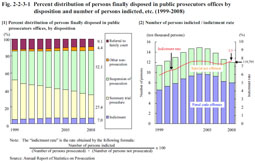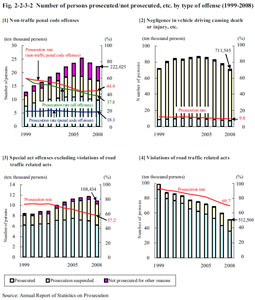| Previous Next Index Image Index Year Selection | |
|
|
Fig. 2-2-3-1 shows the percent distribution of persons finally disposed in public prosecutors offices by disposition, number of persons indicted, and indictment rate over the last 10 years. Of 1,710,862 persons finally disposed in public prosecutors offices in 2008 (including juveniles), the number of those indicted was 119,795 (7.0%), that of those placed on the summary trial procedure was 468,162 (27.4%), that of those granted suspension of prosecution was 890,758 (52.1%), that of those not prosecuted for other reasons was 75,789 (4.4%), and that of those referred to family courts was 156,358 (9.1%). The number of persons indicted had been increasing every year from 1995, but started to decrease in 2005. In 2008 it decreased by 5,992 persons from the previous year (See Appendix 2-2). Fig. 2-2-3-1 Percent distribution of persons finally disposed in public prosecutors offices by disposition and number of persons indicted, etc. (1999–2008) Fig. 2-2-3-2 shows the number of persons finally disposed in public prosecutors offices who were prosecuted, granted suspension of prosecution, or not prosecuted for other reason and prosecution rate by type of offense over the last 10 years (See Appendix 2-3).Fig. 2-2-3-2 Number of persons prosecuted/not prosecuted, etc. by type of offense (1999–2008) Table 2-2-3-3 shows the number of persons not prosecuted in 2008 by reason (limited to cases for non-traffic penal code offenses and special act offenses excluding violations of road traffic related acts).Table 2-2-3-3 Number of persons not prosecuted by reason (2008) |


